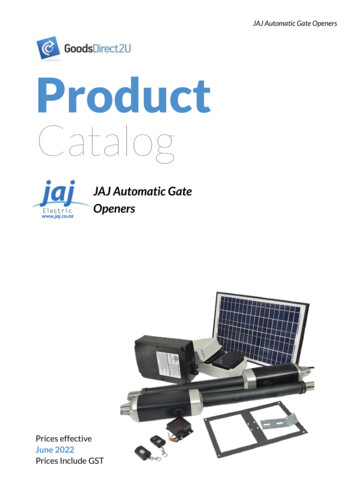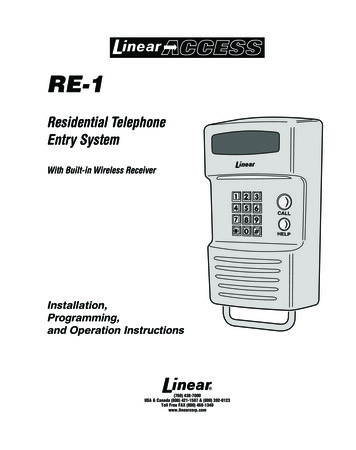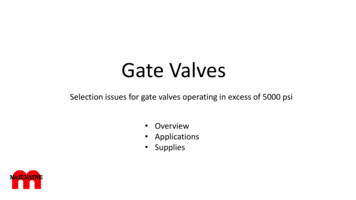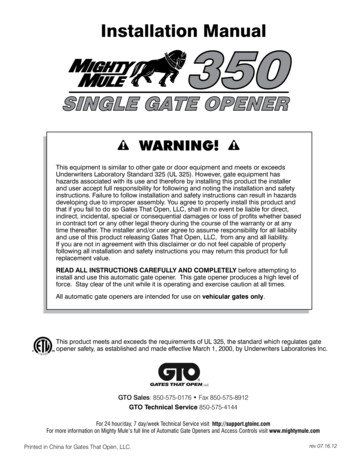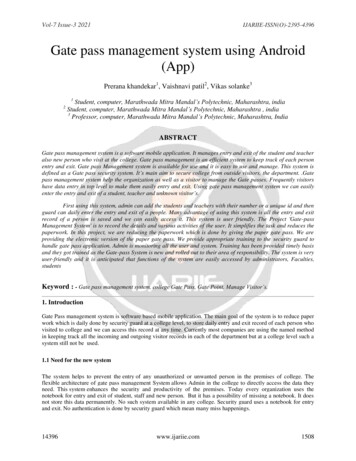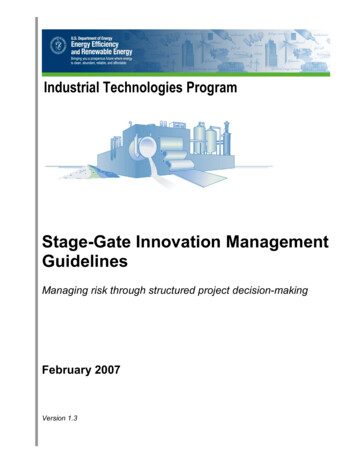
Transcription
Industrial Technologies ProgramStage-Gate Innovation ManagementGuidelinesManaging risk through structured project decision-makingFebruary 2007Version 1.3
Table of ContentsOverview of ITP Stage-Gate Innovation Management . 1Background . .1Process Overview . .1Stages and Gates . .2General Description . . 2ITP Stage-Gate Model . .3Benefits of Structured Project Decision-Making .Alignment of Stage-Gate with ITP‘s Portfolio/Agreement Review Process 45Implementation of the Stage-Gate Process . Project Team . .66Roles and Responsibilities . Gate Reviews . .68Gate Decisions . .8Stage Descriptions and Gate Review Criteria . .Stage 1: Preliminary Investigation and Analysis . .910Gate 1: Select Research Project . .Stage 2: Concept Definition . 1012Gate 2: Research Approval . .12Stage 3: Concept Development . .14Gate 3: Proof of Technical Feasibility . . 14Stage 4: Technology Development and Verification 16Gate 4: Proof of Commercial Feasibility . . . . . . . . . .Stage 5: Information Dissemination and Commercialization 1618Summary . 19References . . 20Glossary of Terms . . 21Appendix A: Gate Review Template . . 23Stage Gate Innovation Management GuidelinesIndustrial Technologies Program
Overview of ITP Stage-Gate Innovation ManagementBackgroundThe Industrial Technologies Program (ITP) manages a diverse research portfolio (Figure 1) with the overarchinggoal of accelerating the use of innovative, energy-efficient, industrial technologies. It is critical, therefore, that there isan effective pathway for innovative technology and new technical information to reach the end-user. The Stage-GateInnovation Management Guidelines map out this pathway.Figure 1. ITP Core ResearchIndustry Sector-Specific: Aluminum,Chemicals, Forest Products, Glass,Metal-casting, Mining, SteelCross-cutting Technology:Combustion, sensors and controls,materials, energy systemsTechnology Delivery: Best energymanagement practices, IndustrialAssessment Centers, emergingtechnologiesStage-Gate Guidelines are a tool for ITP TechnologyManagers, Field Office Project Managers, and ITP partners toevaluate the progress of projects in the research portfolio and toguide disciplined decision-making throughout the course of anR&D project. The Guidelines are intended to be applied toprojects at the Agreement level (individual technology) inEERE‘s Corporate Planning System (CPS).To broadly accomplish its energy efficiency mission, ITP hasdesigned the Stage-Gate process with flexibility toaccommodate its various types of research projects. Whetherthe project is basic science or technology development, theStage-Gate process contains the guidance that increases theprobability of successfully bringing new energy technologies toU.S. industry.Process OverviewITP‘s Stage-Gate process is a multi-step approach of logical thought and decision making for use by ITP managersand their partners in conceptualizing and developing new processes and products. It is a project-based process thataids in the delivery of energy saving technologies to U.S. industrial energy users. Stage-Gate is an enabler ofeffective R&D and a guide to best practices, not a rigid set of rules to be followed without exception.ITP‘s process is built on a foundation of EERE RDD&D practices combined with best methods from generalbusiness. ITP Stage-Gate Innovation Management Guidelines are based on Stage Gate principles (a registeredtrademark of R.G. Cooper & Associates), a methodology which has been successfully applied throughout industryand government (Cooper 2002, Cooper 1998, GRI 1995).Stage-Gate is a phased project management approach that produces fact-based funding decisions based on a setof defined evaluation criteria. Specifically, the Stage-Gate approach will be used by ITP to: Provide consistent program and project management guidelines Characterize projects in terms of scope, quality, performance, and program integration Evaluate and monitor project progress against milestones Assess viability of technology commercialization Guide decisions on project funding (e.g., Go Forward, Stop, Hold, Return)A key tenant of the Stage-Gate model is that R&D is inherently risky and only a small percentage of new ideas willfind commercial use. Therefore, funding commitments for projects are initially low and typically focus on uncertaintechnical elements. Research to show the technical and economic potential for a technology in successive projectstages provides important information for making judgments about the project and for committing funding in the longterm. The expectation is that projects with serious technical or other issues will be identified and resolved early-on,enabling greater investment in the projects with the greatest probability for success in later stages.Stage Gate Innovation Management Guidelines (V 1.3)Industrial Technologies Program1
Stages and GatesGeneral DescriptionThe Stage-Gate process is comprised of a series ofstages and gates, as shown in Figure 2. Each stageis defined by a set of specific research activities;gates are checkpoints where decisions are madebased on pre-determined criteria.Stage1Gate1Gate2Stage2Figure 2. Simplified Stage-Gate Flow DiagramStagesStages are the elements of a project where analytical research and technology development are performed. Thenear term objective of each stage is to make technical progress and gather the information needed to move theproject through the next gate. Information accumulated during each stage is used to reduce levels of technicaluncertainty and economic risk. With this knowledge, researchers can make informed decisions that address bothtechnical and business challenges and reduce the overall uncertainty of the project. Early stages of research anddevelopment typically encounter the highest technical risks; the resources in later stages are most often dedicated toovercoming economic barriers to project success.The Stage-Gate process provides flexibility to gather information, manage risks, and address end-user needs inthe timeliest manner. ITP projects may be initiated at whatever stage is most appropriate. For example, projectsmay be well past preliminary analysis or idea generation, and ready for concept definition when funding is awardedby ITP. Wherever a project begins, however, it can only be in one stage at a time. Therefore, it is critical that a planbe in place to define the work to be accomplished in each subsequent stage.Project funding may also end at the most appropriate stage. For example, industry may want to undertakeportions of the technology development stage on their own without Federal funding due to proprietary or intellectualproperty issues. In some cases, DOE funding on an individual project may be for one select stage in the R&D cycle,with the private sector funding the remaining stages.GatesGates are decision points for initiating funding or moving forward with a project. At each gate the following occurs: A set of criteria is used to judge the progress of the project A decision is made as to whether the project should go ahead, be delayed, or stopped Approval of funding is made for the next stage A path forward for the next stage is presented and approvedEach gate has a unique set of quantitative and/or qualitative criteria for determining whether ITP should initiatefunding or approve the project into the next stage. Criteria are designed to answer salient questions such as: Have critical technical milestones been met? Is project on time and within budget? Does the concept still have potential to provide benefits to the end-user? Does the concept continue to fit with ITP goals and strategies?The current stage of the project is determined by whether it has met all the criteria for preceding gates. As statedearlier, a project may enter the process at whatever stage is most appropriate. However, all previous gate criteriamust have been met. For example, a proposal may be submitted where the criteria for Gate 2 have already beenmet. In this case the project could enter the process at Stage 3.Progression through each gate is determined by gatekeepers who are identified at the time the project begins. Thegatekeepers determine whether the project moves forward given the information developed in the preceding stage.Stage Gate Innovation Management Guidelines (V 1.3)Industrial Technologies Program2
The ITP Stage-Gate ModelITP‘s model for the Stage-Gate process focuses project management activities on the delivery of energy savingtechnologies and information to U.S. industrial energy users. The Process directs ITP and its partners to considerthe prospects for commercialization from the start of a project to its conclusion. Planning for commercializationcannot wait until the end of a project. Studies have repeatedly demonstrated that a major reason for R&D failing toproduce a market impact is the neglect of market, business and financial factors early in the R&D process.Within ITP‘s research and development program, successfully completed projects result in one of two outputs thatmake an impact: Products or Information. Products, in general, are hardware, software, or process designs that aresold by equipment manufacturers, engineering design firms, or other commercial entities to energy users.Information is a knowledge-based result (e.g., database development, properties and behavior characterization, andmodeling and simulations), which ITP disseminates to technology developers or the industrial sector; this newknowledge ultimately leads to reduced energy intensity. R&D activities designed to address a technical problemwithin an ITP product development effort should be integrated into a single Stage-Gate project. Whether the outputis a technology product or information, a successful project always delivers benefits to the end-user.STAGE 1STAGE tion& Analysis& AnalysisSTAGE 2STAGE 2ConceptConceptDefinitionDefinitionGate2STAGE 3STAGE 3ConceptConceptDevelopDevelopmentmentGate3STAGE 4STAGE 4TechnologyTechnology GateDevelop4Development&ment &VerificationVerificationSTAGE 5STAGE 5InformationInformationDisseminDissemination &ation rFigure 3. Stage-Gate Process FlowFigure 3 is intended as process outline only. ITP technology development projects are not required to enter theprocess at Stage 1 and exit at Stage 5; project funding may begin at any stage and end at any stage in the five stageprocess. Stages may not be skipped, however, and should be followed in sequence. A typical DOE R&Dcommercialization project may begin at Stage 2, Concept Definition, and end after Stage 3, Concept Development,with the intent that the private sector will continue with Stages 4 and 5, Technology Development andCommercialization.StageGate1.Preliminary Investigation and Analysis: Scoping studies to identify research topics;technical and market assessments; idea generation.1.Research ProjectSelection2.Concept Definition: Early stage research to explore and define technical concept or toanswer a specific technical question; laboratory scale research.2.Research Approval3.Concept Development: Development and testing of prototype technology or process;development of models and informational databases; predictive modeling or simulationof process or equipment performance; evaluation of system scalability and end-useracceptability; demonstration of concept feasibility at prototype or bench scale.3.Proof of TechnicalFeasibility4.Technology Development and Verification: Pilot scale development of technology orprocess; verification and documentation of technical performance and validation ofeconomic potential in field test(s).4.Proof of CommercialFeasibility5.Information Dissemination and Commercialization: All activities necessary forinformation delivery and commercial launch (production scale technology manufactureand installation; development of market infrastructure; demonstrated commercialoperation).Stage and gate criteria have been developed that are uniquely suited to the type of projects funded by ITP. Thesection on Stage Descriptions and Gate Review Criteria beginning on Page 9 provides more details on suggestedactivities and decision-points.Stage Gate Innovation Management Guidelines (V 1.3)Industrial Technologies Program3
Benefits of Structured Project Decision-MakingA consistent set of management guidelines, which can be followed throughout ITP, will improve accountability andpave the way for timely, fact-based decision-making. Stage-Gate Guidelines lead to a higher percentage ofsuccessful projects in the R&D portfolio by enabling effective communication among technology managers, projectmanagers, contractors, equipment manufacturers, end-users and other project participants. Specifically, a structuredinnovation management process provides ITP with a tool for: Risk management through enhanced project prioritization Improved quality of execution Fact-based decision-making Parallel, multi-functional R&D Effective end-user involvement Idea generationRisk management through enhanced project prioritizationMost of the projects funded by ITP are inherently high-risk ventures that industry is unable to undertakeindependently. The Stage-Gate process manages R&D risks by prioritizing the use of resources and ensuring theyare properly allocated, based on the potential for successful research outcomes. For example, Stage-Gate identifiespoorly performing projects and those that will not meet expected technical objectives. If appropriate, resources canthen be diverted to entirely new projects or to projects with greater promise for success, expediting the path tocommercialization. A well-implemented project decision process can shorten the time to market by 30% or more*.Improved quality of executionBy anticipating and focusing on —road-blocks“ early in the process, project decision-makers can monitor researchand technical development and assess commercial feasibility while minimizing the use of resources. Quality ofresults is also improved by defining goals, activities and outputs ahead of time; ensuring that all key issues havebeen addressed.Fact-based decision makingWhen stages and gates are clearly defined with pre-specified goals and outputs, decision-makers are able toquickly and factually formulate judgments based on the performance of the project. Gate criteria are based oncurrent technical, market, financial and operations information in order to make well-informed decisions.Parallel, multi-functional approach to R&DTo address and resolve interdependent issues such as technical performance, energy savings, market potential,economics, safety and environmental impacts, each stage of the Stage-Gate process requires multiple kinds offunctional expertise. When technical research is conducted in parallel with other important studies and information isshared frequently, impediments to overall project success are addressed as early as possible.Effective end user involvementIdentifying the needs and concerns of end-users, equipment manufacturers, and other potential partners early inthe process helps ensure that private industry will be interested in partnering once the project reaches the productionand commercialization stage. The level of industry involvement will become greater and more focused as the projectmoves though the stages, but their input must never be absent in defining the concept, and in developing, testing,and validating the technology.Idea GenerationStage-Gate incorporates a —homework“ stage to gain insights on potential research and development areas.Preliminary, early-stage analysis is less expensive than laboratory or pilot-scale activities and provides insights onthe future commercial potential of the technology. It is an effective way to prioritize various project options.* Stage Gate Innovation Management Guidelines (V 1.3)Industrial Technologies Program4
Alignment of Stage-Gate with ITP‘s Portfolio/Agreement Review ProcessThe Stage-Gate Innovation Management Guidelines have been developed to complement ITP‘s current decisionmaking processes and enhance its effectiveness. Stage-Gate Guidelines are not intended to replace existing projectmanagement and funding review approaches, rather to provide structure so that funding decisions are consistent andthat the potential for success of the entire ITP portfolio is increased.EERELevelProgramLevelVisionStrategic goals/objectivesStrategiesStrategiesTechnical requirementsFunding nningPlanningProjectsSpend plansAcquisition PlansProjectLevelObligationsProgram guidance lettersWork authorizationsContracts, plementationGateGateNext StageFigure 4. Stage-Gate aligns with AOP and Implementation steps of EERE‘s Program Management CycleContracting and budget allocation are two key management controls in ITP‘s program. Using Stage-Gateguidelines in combination with proven management practices within ITP help optimize the allocation of funds within ofthe R&D portfolio. A clear link between Gate decision criteria and overall project objectives œ in solicitations,proposals, and financial awards œ leads to focused, fact-based, and balanced project decision-making.Financial awards should follow Stage-Gate guidelines to the fullest extent possible, including appropriatereferences to stage activities and gate review criteria during the solicitation and proposal process. Some financialassistance awards, including the contractual agreements overseen by the DOE Field Offices, are currently structuredaccording to budget periods to aid decision-making. Budget periods provide a convenient timeframe for the DOEProject Management Centers (PMC) to decide if a project is meeting its objectives and to discontinue if warranted.As a project approaches the end of a budget period, the PMC typically asks the project team to provide acontinuation application that details the progress of the project to date. The continuation application process is onemechanism to integrate stage-gate principles into existing projects by aligning go/no-go decision points with StageGate decision criteria. New awards embody Stage-Gate management approaches when the guidelines areincorporated into solicitations and gate criteria are part of the merit review process.ITP regularly appraises program activities in merit reviews, project reviews and portfolio reviews in order to ensurethat the program is focusing its scarce resources on the most important technical opportunities. ITP TechnologyManagers are currently responsible for arranging annual or biannual portfolio review meetings. While portfolio reviewmeetings may not always coincide with Stage-Gate gate decision points because of the project timeline or the size ofthe project, Stage-Gate methods and terminology should be integral in planning and executing the reviews.Depending on project timing, gate review meetings may be conducted concurrently with other project/agreementreview meetings. Gate review meetings may also be more informal, possibly in the form of a conference call.Stage Gate Innovation Management Guidelines (V 1.3)Industrial Technologies Program5
Implementation of the Stage-Gate ProcessThe basic Stage-Gate process (Figure 5) is comprised of a series of gates where individual projects are reviewed,and a series of stages to accomplish theProject Team selected Projectwork necessary to move the project Project Team selectedcriteria developed Stage criteriaGate1forward. Essentially, the Stage-Gate Stage criteria developedGate 1 Gatekeepers selectedProject GatekeepersselectedProjectprocess restricts investment in the nextPreliminarydeve loped (Principal Preliminary R&D plan developed(PrincipalSelection InvestPreliminaryR&Dplan developed (PrincipalSelectionInvestigator)igator)stage until management is comfortableInvestigator)with the outcome of the current stage.Implementation of the process requiresa project team with clearly delineatedroles and responsibilities. These areoutlined in the following sections.Stage 2Stage 2Concept DefinitionConcept Definition Research is conducted Research is conducted Results DocumentedResults Results Documented Gate review planned (Principal Investigator)(PrincipalInvestigator) Gate review planned (Principal Investigator) R&D plan developed for next stagedeveloped tor) for next stagePrInvest(Principal Investigator)Project Team Results are presented (Principal(PrincipalResultsUpon project award, the first step is to InvestResultsareigator) presented (PrincipalInvestigator)Gate2Investigator)establish a Project Team and to identifyGate 2 Results reviewed against criteriaResultsagainstcriteriaResearch ((Gatekeepers)Results reviewed against criteriagatekeepers. Gatekeepers, typically al ProjectProject decisionsdecisions are made (Gatekeepers)Technology Managers and DOE Field Project decisions are made (Gatekeepers) R&D plan for next stage presented andOffice staff, are responsible for deciding reviewedR&D planfornextstage ipresentedandinci(Prpal Investigator)Investgator)(Principalreviewed (Principal Investigator)whether the project goes forward to thenext stage. Project Teams vary inNext Stagecomposition depending on the nature,size and stage of the project. OutsideFigure 5. Representative Stage-Gate Process Implementationexperts may be called on at variousgates to provide input in specific technical or business areas. Every project team has a Principal Investigator who isresponsible for project execution and interaction with gatekeepers. The Principal Investigator should remainunchanged during the ITP Stage-Gate process. If a change in Principal Investigator is unavoidable, the DOE FieldOffice Project Manager, in consultation with the ITP Technology Manager, must approve the change.Roles and ResponsibilitiesDOE Headquarters/ITP Technology ManagersITP Technology Managers are responsible for all funding decisions and ensuring that DOE Field Office ProjectManagers apply Stage-Gate guidelines appropriately. Technology Manager responsibilities include: Strategic context for project selection and review Providing documentation of ITP program strategic planning and analysis Guidance on ITP program priorities and mission Guidance on solicitation objectives Gate Decisions and Project Planning Providing input to Gate decision criteria development Participating in Gate reviews for large, high profile projects Providing clear decisions and recommendations during/after Gate reviews Allocating funding for approved projects Reviewing R&D stage plans for larger R&D efforts Verifying that gatekeeper comments have been documented and addressed Project status and review Holding program/portfolio review meetings that cover project status reviews Interacting with Principal Investigator and Field Office Project Manager to resolve project issuesStage Gate Innovation Management Guidelines (V 1.3)Industrial Technologies Program6
DOE Field Office Project ManagersDOE Field Office Project Managers are responsible for applying the Stage-Gate guidelines to projects under theirpurview. Specific responsibilities include: Gate reviews Providing input to criteria development Identifying external gatekeepers as necessary Setting target dates for review meetings Participating as a gatekeeper Reviewing and approving detailed R&D stage plans Reviewing results and making recommendations for funding decisions Verifying that gatekeeper comments have been documented and addressed Project status and review Participating in program/portfolio review meetings where project status is reviewed Interacting with Principal Investigator to resolve project issues as appropriate Stage management Contracting/arranging resources Tracking progress versus budgets, schedules and scope Facilitating task execution Communicating status, results and accomplishmentsPrincipal InvestigatorThe Principal Investigator is a member of the team conducting the R&D and heads up the Project Team. He/she isgenerally responsible for planning and running the Gate review meetings and other tasks. Specific responsibilities ofthe Principal Investigator include: Executing and controlling the project stages Gathering and analyzing information Researching and developing technology Documenting results and progress Monitoring budget and schedules Communicating with ITP managers and end-users Distributing outputs and stage plans to the Project Team in advance of review meetings Holding dry runs of prior to Gate review Developing materials for the review meeting Presenting stage accomplishments Addressing review criteria Presenting the plan for next stage Revising and distributing Stage plans Documenting gatekeeper commentsGatekeepersGatekeepers are individuals or groups of individuals that are responsible for deciding whether a project shouldcontinue and receive funding for the next stage. Gatekeepers are typically internal DOE managers and outsideexperts and may vary gate by gate. ITP project gatekeepers will typically be DOE Field Office Project Managers, andfor large, complex projects, may include ITP Technology Managers. Final gate decisions and funding allocations aremade by ITP Technology Managers. DOE Field Managers are responsible for making recommendations to the ITPTechnology Managers regarding continuation of projects. Specific responsibilities for gatekeepers include: Review of results against preset gate criteria Gate decisions and funding allocations (ITP Technology Managers) Recommendations for revisions to the R&D plan going forwardStage Gate Innovation Management Guidelines (V 1.3)Industrial Technologies Program7
Gate ReviewsGate reviews are held to evaluate the progress of each project against a set of criteria that are defined at theoutset of each stage. Work completed during a stage produces the information needed for decision-makingregarding continued funding of a project. Other key outputs from the Gate review include pre-determineddeliverables (e.g., R&D stage plan, testing results).Criteria are different for each gate and become more rigorous as the project progresses. The criteria are presetand a list of rules are agreed upon to keep the review process unbiased. The needs of a particular project determinewhen and how gate reviews take place. The Principal Investigator and DOE Field Office Project Manager usuallycollaborate in setting target dates for gate reviews.R&D Stage PlanA Stage-Gate management plan should be developed for each project upon award, with input from the entireproject team. In addition, the R&D stage plan should be updated by the Principal Investigator prior to moving on tosubsequent stages. At a minimum, this plan should include: Research objectives for the individual stage Major technical milestones Commercialization or information dissemination objectives Work breakdown structure and schedule Resource requirementsAt each gate review, the R&D stage plan for the next stage must be presented in sufficient detail for the reviewersto comment on the goals, activities and outputs. This plan may also be revised by gatekeepers at the gate review tobetter reflect technical objectives and funding levels.Gate DecisionsGates must have clear, well-understood criteria so that gatekeepers can make objective and timely decisions.Criteria must be specific enough to engage management in the decision process and enable them to ascertain therisks and benefits of going forward. Gate scorecards may be used by gatekeepers to compare projects within aprogram area as appropriate.Gate decisions are made by ITP Technology Managers during or following each gate review. DOE Field ProjectManagers and other gatekeepers will provideinput and recommendations for the decisionFigure 6. Possible Gate Review Decisionsmaking process.GO FORWARD œ goals for the previous stage were met;technical, market, financial and operational informationhas met expectations; and funding is approved for thenext stage (dependent on annual funding appropriationby Congress).STOP œ project is not progressing as it should becausethe market has shifted permanently, the technology isobsolete, or desired technical objectives cannot be met.HOLD œ project has been suspended for a specifiedperiod of time and the criteria will be re-evaluated at afuture date.RETURN œ goals have not been accomplished or thecriteria have not been met, but because the project is stilla high priority, the team will return to the previous stageto complete the work.Stage Gate Innovation Management Guidelines (V 1.3)Industrial Technologies ProgramPossible gate decisions are shown in Figure 6.If a go forward decision has been
the prospects for commercialization from the start of a project to its conclusion. Planning for commercialization cannot wait until the end of a project. Studies have r epeatedly demonstrated that a majo r reason for R&D failing to produce a market impact is the neglect of market, business and financial factors early in the R&D process.
